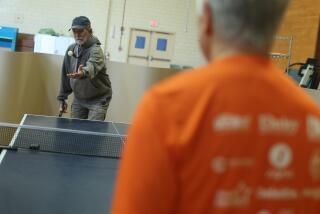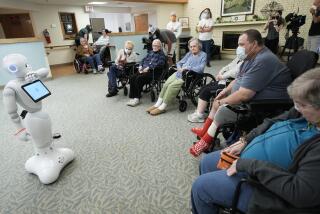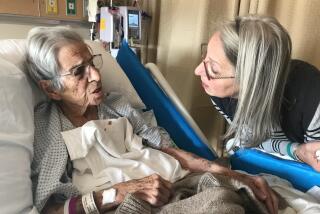A Vital Program for Elderly Who Care
- Share via
Bernice Erenberg’s slow road to despair started with her husband’s driving.
The 78-year-old Oak Park resident noticed that her husband, Herbert, couldn’t go from one point to another without first driving home and starting out all over again.
Over the next three years, Alzheimer’s disease transformed Herbert into a large child who depended on Bernice to bathe him, feed him and change his diapers.
Bernice was already caring for her two mentally ill children, both in their late 40s, who lived at home. Overwhelmed by stress, she quit teaching piano and lost her friends, withdrawing from the things she enjoyed most in life.
She became so isolated that she found it difficult to speak, her long periods of silence broken only by encounters with grocery clerks and bank tellers.
“My nerves are shot,” Erenberg said in her neat home overlooking a canyon, her friendly eyes filling suddenly with tears. “I’m not so nice to my husband sometimes. I don’t even have time to think. If I could only get away for a while. . . . But it’s impossible.”
Bernice is just one of the many elderly people who provide around-the-clock care for an ailing loved one. Bound by unrealistic expectations of themselves, and a strong sense of loyalty, these care givers often neglect their own well-being to the point that they become mentally or physically ill, often ending up in the hospital.
But Bernice found Bob Torres-Stanovik, who runs Caregiver Education Support Services, or CESS, a program within the county Health Department. It was designed for people who care for an elderly person suffering from a mental illness such as depression or Alzheimer’s disease.
“The person who takes on the job of care giver takes on the world,” Torres-Stanovik, a licensed clinical social worker, said. “They are responsible for money and medications. They are a friend, lover, housekeeper, plumber, carpenter and cook.
“Maybe at one time, the care giver was able to do all these things. But, as a person becomes older and more frail, they sometimes just don’t stop and say, ‘Oh my gosh, I need help!’ ”
Torres-Stanovik keeps track of 30 care givers throughout the county. In each case, the care receiver is at least 55 years old, has been diagnosed with a mental illness and lives at home. In 80% of the cases, there is an elderly spouse taking care of everything.
“We see very few sons and daughters,” Ray Schwartz, who oversees CESS and other programs for seniors, said. “The rest of the family walks away from the problem and just leaves the elderly person to care for their spouse all by themselves. And then they blame them because the conditions are getting worse. They criticize the care while they lay back. . . . It’s more than sad. It’s a death sentence.”
Schwartz manages the county’s Seniors Counseling and Training program for the case management section of Mental Health Services. Unlike the county’s Area Agency on Aging, CESS focuses on the care giver rather than the care receiver.
There are dozens of little-publicized services available to care givers, Torres-Stanovik said. His job is to assess the family’s needs and coordinate services to fill those needs with other agencies, which provide everything from social day care to financial planning.
“Care-giver support groups are one of the best ways to break the isolation and get them connected to other people,” Torres-Stanovik said, adding that the number of support groups meeting in the county has grown from half a dozen to 30 in the past few years.
Most of the time, Torres-Stanovik’s clients are brought to his attention by police, social workers, and concerned relatives and friends. One woman became a client after she collapsed and was hospitalized for a week, malnourished and exhausted from caring for her husband. The husband had to have his windpipe suctioned out at frequent intervals, 24 hours a day, because of a tracheotomy.
Besides physical symptoms that a burned-out care giver shows, mental warning signs also signal a problem. Care givers may become irritable, depressed, frustrated and even angry at their situation. They may feel consumed by guilt, unable to enjoy themselves because the care receiver cannot, or because the common thought of wishing the care receiver would die has crossed their mind.
Whatever the feelings, Torres-Stanovik said, it is important to recognize and accept them.
CESS publishes a handbook that looks into issues facing care givers, as well as listing agencies and their services. Inside the free publication, care givers can rate themselves on a scale, which ranges from abusing or neglecting the care receiver to providing too much care by ignoring one’s own needs.
In a healthy situation feelings are communicated between the care giver and care receiver in an empathic, non-judgmental manner, and the needs of both are met.
Scores at the ends of the scale represent extreme situations that must be changed. One of the options is placing the care receiver in a nursing home.
Nursing homes are not the same as home care, but offer many advantages, Torres-Stanovik said. There is a medical staff on hand and a social atmosphere that may be lacking at home. The care giver also can get a good night’s sleep and stay healthy.
According to Schwartz, deciding to place a spouse in a nursing home is the most difficult decision a care giver makes.
“There is tremendous guilt involved,” he said. “Often, they feel they made a pact--’until death do us part.’ That is the pact they feel ethically and morally bound to go through with.”
Bernice had been a care giver all her life, first for her elderly parents, then her own family. Nursing homes were something she never seriously considered.
Herbert’s worsening condition meant the loss of the one person Bernice could depend on. He began wandering from the house, sometimes running from Bernice like a naughty child.
One time he wandered into a McDonald’s restaurant. Employees alerted county social workers, who took him home and asked Bernice to call Torres-Stanovik.
“I don’t feel capable,” she said, describing her task of running the household alone. “I’m tired. I’m afraid of getting sick, because what would happen to my family?”
Torres-Stanovik’s assistant, Mary Broutin, immediately began working with Bernice. The San Diego State University student-volunteer helped Bernice with shopping, which she had been doing by bus. She helped her with bank errands and encouraged her to take her medication for glaucoma faithfully, a small task that Bernice often neglected to do.
Broutin introduced Bernice to several nursing homes in the county to show her what they were like.
“Two months later,” Broutin said, “she brought the subject up on her own. I just planted the seed.”
Broutin helped place and move Bernice’s 48-year-old daughter, who suffers from hallucinations, into the home. The arrangement has been successful, and the daughter comes home for visits frequently. They are now looking at other homes for Herbert.
Bernice said that, not only has Broutin been a great help, she has been a friend.
“I had an overflow of things bottled up in me,” she said. “Now, I have somebody to talk to.”
More to Read
Sign up for Essential California
The most important California stories and recommendations in your inbox every morning.
You may occasionally receive promotional content from the Los Angeles Times.









